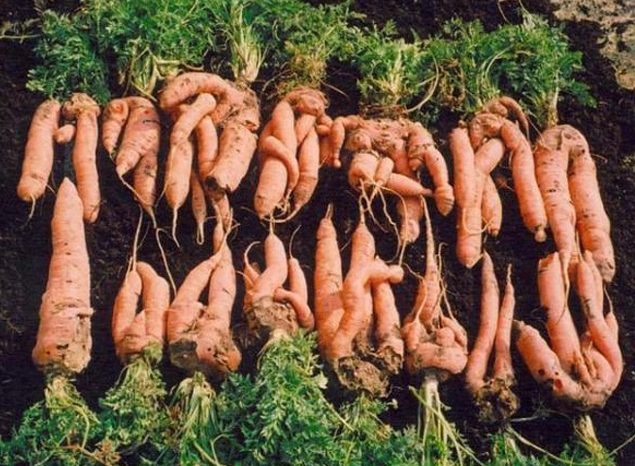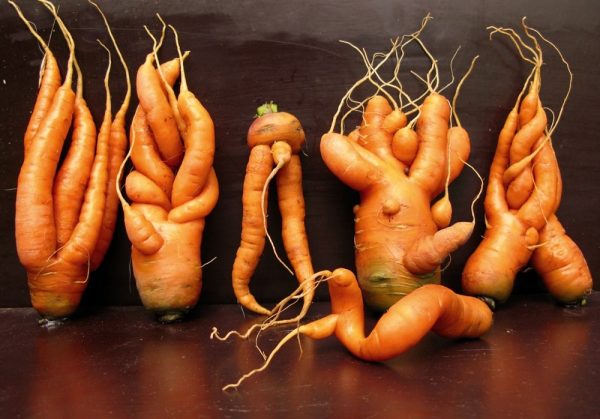Why are carrots “horned”?
- Carrots grow “horned” in beds where fresh organic matter was added before sowing.
- Gnarled carrot roots grow in sandy soils with sparse plantings.
- The crop also grows abnormally if a dense layer, impervious to roots, has formed under the treated soil layer - the “sole”.Having reached it, the tip of the root crop dies off, and lateral branches begin to grow (as on a branch after pinching).

This is the kind of crop of horned carrots that can grow in a garden bed.
What to do?
We sow the seeds in well-lit, ventilated beds so that it grows more actively and is not damaged by the carrot fly and does not get sick with fungal diseases.
In order for carrots to grow without horns, we deeply cultivate the soil in the garden bed, add phosphorus-potassium fertilizers, but not organic matter: it is applied under the previous crop. That is why it is good to place carrots after potatoes, cabbage, cucumbers, and zucchini.
If the crops are dense, we thin them out, increasing the distance between the root crops to 4-5 cm. After thinning, we carefully hill them up to give the root crops stability and protect them from exposure to the sun.

And as soon as such clumsy freaks grow up.
How to feed
It is advisable to feed carrots 2-3 times during the growing season, especially on poor soils.
- The first feeding is at the stage of 3-4 true leaves: a glass of organic infusion or a tablespoon of complex fertilizer in a bucket of water.
- The second feeding is 2-3 weeks after the first: 2 tablespoons of complex mineral fertilizer per 10 liters of water.
- The third feeding is during the growth period of root crops: a tablespoon of potassium sulfate per bucket of water.
How to water
When watering carrots, we take into account that they need the most moisture during the periods of seed germination and the formation of root crops. One overdrying of the soil is enough for either the seedlings to become sparse or the root crops to grow clumsy. The soil in the carrot bed should not dry out. After each watering, if the rows are not mulched with compost, we loosen them.
We are not late with carrot harvesting, focusing on the ripening periods of root crops indicated in the annotation of the variety. And one more note: on heavy, compacting soils it is better to sow short-fruited varieties and hybrids. By the way, the taste of carrots depends not only on agricultural technology, but also on the variety. We give preference to varieties with brightly colored root crops with a thin core. These characteristics must be given in the descriptions.

Just a puppet theater
Why do carrots grow limp and soft?
To accurately answer why the carrots grew limp, you need to know what variety you sow and when you harvest them. The fact is that for our gardens we most often choose early varieties and sow them in March-April, as soon as the soil thaws, or even before winter.
With such sowing dates in June and early July, the carrots are already ready. But we feel sorry for removing it all at once. We'll pull out one or two carrots for soup, and keep the rest in the garden until autumn. This doesn’t make it any tastier or juicier. Experts advise having a small bed of early carrots for early consumption, and choosing late varieties for winter, or sowing early ones, but in the summer.

Jokers...
Agricultural technology is also important. Deep tillage of the soil before sowing, timely fertilizing, watering, loosening, thinning, hilling. For example, carrots that lack phosphorus and potassium it won't be sweet. If there is a lack of moisture, the root vegetables will be soft and limp.
Excess fertilizer will also negatively affect quality. Carrots that are not hewed in time will taste bitter: the green top will worsen the taste of the entire root vegetable. Root crops damaged by carrot flies will taste bitter: this is how plants protect themselves from attack by the “enemy.”

 (11 ratings, average: 4,45 out of 5)
(11 ratings, average: 4,45 out of 5) CUCUMBERS NEVER GET SICK, I'VE BEEN USING ONLY THIS FOR 40 YEARS! I SHARE A SECRET WITH YOU, CUCUMBERS ARE LIKE THE PICTURE!
CUCUMBERS NEVER GET SICK, I'VE BEEN USING ONLY THIS FOR 40 YEARS! I SHARE A SECRET WITH YOU, CUCUMBERS ARE LIKE THE PICTURE! You can dig a bucket of potatoes from each bush. Do you think these are fairy tales? Watch the video
You can dig a bucket of potatoes from each bush. Do you think these are fairy tales? Watch the video
 How our fellow gardeners work in Korea. There is a lot to learn and just fun to watch.
How our fellow gardeners work in Korea. There is a lot to learn and just fun to watch. Eye trainer. The author claims that with daily viewing, vision is restored. They don't charge money for views.
Eye trainer. The author claims that with daily viewing, vision is restored. They don't charge money for views. A 3-ingredient cake recipe in 30 minutes is better than Napoleon. Simple and very tasty.
A 3-ingredient cake recipe in 30 minutes is better than Napoleon. Simple and very tasty. Therapeutic exercises for cervical osteochondrosis. A complete set of exercises.
Therapeutic exercises for cervical osteochondrosis. A complete set of exercises. Which indoor plants match your zodiac sign?
Which indoor plants match your zodiac sign? What about them? Excursion to German dachas.
What about them? Excursion to German dachas.